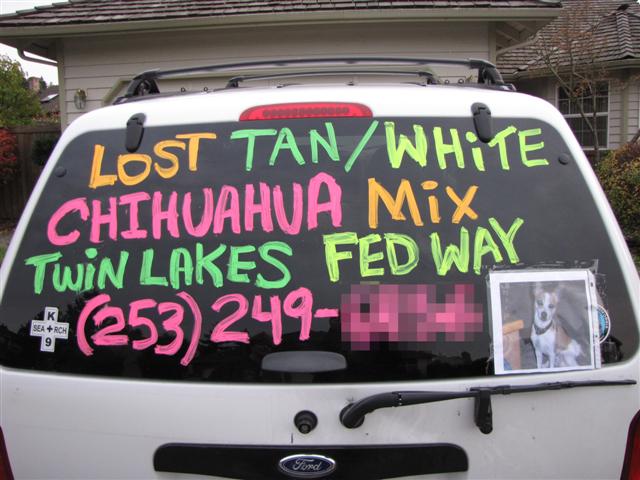



Lost Dog Search & Rescue

Lost Dog Search Team
Use this information as a guide to find your lost dog:
-
* Check the immediate surroundings first, such as your yard and neighboring yards.
-
*
 Contact your local Police and
Animal Control, post your flyers at every dog friendly place you can
think of including veterinarian offices, local dog parks, Pet Smart,
Petco, supermarkets, Post Offices, Wa Wa's, Quick Check ETC. and let
them know your situation
Contact your local Police and
Animal Control, post your flyers at every dog friendly place you can
think of including veterinarian offices, local dog parks, Pet Smart,
Petco, supermarkets, Post Offices, Wa Wa's, Quick Check ETC. and let
them know your situation -
* Enlist your friends and neighbors in the search. The more people searching for your pet the better.
-
* If your dog likes car rides, drive around your neighborhood calling the dog's name, hoping that he will run from where he is and jump into the car. Just be sure that you don't call your dog into incoming traffic.
-
* Tell everyone you see you are looking for your dog and to induce the dog to enter an open garage or fenced backyard. Give everyone your dog's poster.
-
* Sometimes it's best to pursue the dog by foot because you can go between homes and take unpredictable routes...just as your dog is likely to have done. Again, alert people as you go.
-
* In a survival mode your dog may seek shelter at night and forage for food early in the morning and travel in daylight so It is wise to search around day-break and while the sun is out.
-
* If you spot your dog, DO NOT CHASE HIM! your dog may be in a state of shock, he may not recognize you at first and think you are trying to harm him and will run from you, and you will never outrun a dog. The best chance for you to safely get his attention is to drop to the ground and call your dog. If you and your dog took obedience classes and he responds to "sit/stay!", you have the added advantage of potentially stopping his escape because he remembers his training.
-
I recently came across a search page that stated: "Do Not Allow Family, Friends, or Volunteers to “Search” For Your Dog. Ask Them To Flyer instead" That is the furthest thing from what you want to do. If something is lost, NO MATTER WHAT, the only way to find it is to look or search for it. You want as many eyes looking for your lost pet as possible and the key is to let all your searchers and anyone you come in contact with know what to do and how to act. Have the searchers carry lost dog flyers with them to hand out but their primary function should be to look for the dog and not to create a commotion or scare an already frightened dog further away. Here are some basics:
#1 use COMMON SENSE!
#2 see Rule #1
#3 All searchers should remain calm and quiet and not be in groups larger then 2
#4 Have the owner or search leaders phone number programmed in your phone and ready to dial should you see the dog
#5 If you see the dog you are looking for DO NOT try to approach, call, make eye contact or draw attention to yourself.
#6 Try to follow the dog from a good distance and as soon as you can, call the owner with your location and the direction you are headed.
#7 If the dog shows that much fear that it will not even go to the owner then a trap is the only alternative but to set a trap you need to have at least 2 sightings around the same location. Click on this link to see How & When to use a Trap
For Information on how to conduct a Door to Door Search click here: Door to Door Search Techniques
This is great information from: Lost Dog Search Website
DO NOT CHASE
The dog was chased by the person who lost her, a young boy eager to earn
the reward money, and a nice lady trying to help. Oh, don't forget the
concerned parent who yelled and then ran her out of his yard. Each chase
reinforces a growing perception that ALL humans should be avoided. Today,
a territorial dog was loose and she had to take a different, difficult,
and much longer route to a reliable source of water. Now wary of everyone
and everything, the lost dog runs away from the slightest
attention.
THINK LIKE A DOG
Dogs wander primarily in residential areas where water, food, and places
to shelter are easier to find. They can settle in one area for weeks,
months, or years as long as basic needs to survive are met.
Attracted to the scent of farm animals, dogs might find access to water,
food, bedding areas, or hay barns. They sometimes play with friendly dogs
that are chained up, fenced in, or loose and running around. The yards
most visited provide shelter or food, are animal/nature friendly, or
remind them of home.
Water can be found at streams, lakes, ponds, puddles, water gardens, Koi (fish) ponds, and kid's pools. Things they might eat: food litter, rodents, birds, snakes, birdseed, acorns, manure, insects, and road kill. With a little luck, dogs can find bowls of water and kibbles left outside for the pets of local residents. Alone or in a "colony," feral cats are often fed by individuals every day in the same aromatic spot. It's a "no-no," but people still leave food out on a regular basis for foxes, raccoons, and other wildlife. Certain birds (seagulls, crows, and bluejays) can be exceptionally vocal when they see bits of food. Dogs roam through streets that are ready for "rubbish night" to get at promising odors in garbage bags. Drive around before and after pickup to look for ripped bags and excessive trash strewn on curbsides.
Dogs need protective shelters appropriate for current weather conditions. Finding shade on a hot day or a dry spot in a downpour is easier than bunkering in for a snowstorm. A small dog can fit almost anywhere, but a bigger dog has limited choices. A "busy" yard provides a variety of shelters for most any size dog: doghouses, decks, spare/junk autos, evergreens, trailers, piles of debris, carports, sheds, and open barns. Seasonal, vacation, for sale, or unfinished - vacant houses are great places to hide as no one's ever home. Powdery snow gets so cold in sub-zero temperatures that some dogs find it too painful to walk on, and must immediately search for ground that doesn't hurt their paws or a shelter so they can get off their feet.
OK…what's the fastest way to get to everything and not be noticed by the residents or their dogs? Shortcuts are fast, convenient, and used frequently, especially power line access roads. Shortcuts: Golf courses, parking lots, gravel pits, bridal trails, pastures, recreational fields, parks, and cemeteries. Dogs favor homes adjacent to woodlands on dead end streets, cul de sacs, and at the rear of subdivisions. One backyard leads to the yard of a home on a different street - a wealth of travel and escape routes. Many take temporary refuge in the woods behind a yard favored for shelter, food, or dog companionship. They don't normally go that deep into the forest unless chasing after a deer, rabbit, or some other animal. They can follow man-made trails or the barely visible, narrow paths used by wild inhabitants in the area. Dogs often travel along "lines" created by roads, fences, railroad tracks, shrubs, and stone walls.
BUDDY DOGS
Take the dog's best buddy for a walk and get him to bark - HAPPY! A social
butterfly might be enticed to come play or go for a walk. He might not
respond to unfamiliar dogs unless he loves to play with anyone.
Lost dogs are attracted to others, but socializing is now done
solely at their own discretion, or not at all. Note - Some residents
will think you've found the dog if walking one that looks somewhat
similar.
BEDS, TRAPS, BAITS, AND TOYS
For all beds (trap, kennel, or cardboard box) use a color blanket
that will show hairs the dog most sheds. Carefully check dark blankets for
white/light hairs and light blankets for dark hairs AND paw prints. Some
dogs are not comfortable being forced to crouch going into a trap. It is not
the same as crawling under a deck at home in your own yard. If the trap
has a rear door that can be removed, you can make a new entrance that's
easier and less intimidating for big or tall dogs. If you plan to set the
trap to catch the dog after he's been using the "shelter," it's
better to get him used to going in the main entrance, but tie the door to
stay up, even if the dog nudges it. You can set the trap once the dog
learns to clear the overhang. To encourage a dog to be less wary, train
him to walk through the trap. First tie up the front door and
remove the rear one, then lay a trail of food bits leading inside and back
out the other side. If the dog is comfortable enough to "take the
bait" and pass through the trap, then put the rear door on and set to
catch. The dog should accept the one-way entry since its recent experience
was safe, and the reward so tasty. You should always provide the dog with
a wide open path to approach, get near, and go inside the trap. Don't
expect a dog to struggle, dig, or crawl through deep snow or other ground
that proves troublesome.
Bait stored in leak-proof bags is easier to carry, and heat or defrost. Hotdogs are the best all-around bait. Meatballs cooked in red sauce are messy, but excellent. Cooked liver gets mushy but is also very good. Swiss cheese and luncheon meats are okay until you try tossing bits to a dog that's about 40' away. It's easy to forget to bring bait. Store kitty treats, beef jerky treats, and cans of dog food in your car. Remember to bring anything normally used for positive training purposes, like clickers or dog whistles. Keep extra toys in the car: squeaky toys, tennis balls, small stuffed animals, fetch sticks, or Frisbees. A lost dog might steal another dog's toys out of curiosity - even though you never gave him any before. Life-sized stuffed animals in shapes of small dogs, cats, or rabbits can attract a pet to a specific spot or directly into a cage trap. These toys can work quite well if your dog loves to chase cats or rabbits. Leave a brightly colored toy (no scent) as a "test" where your dog (hopefully not another) will see it. Use a toy easily carried, even in a small dog's mouth. Wildlife shouldn't be interested. If picked up but dropped nearby, you've still got a direction of travel. If it disappears, look in the immediate area, and then ask residents if you can spot check their yards, especially known or suspect shelter or food yards.
You left food at a site, but now it's gone and you're not sure if your dog or another animal found it. Food left after dark and gone by morning can be taken by wild or domestic animals, including the dog. Monitor food closely. Anything that disappears during the day is likely eaten by local pets or your dog. Dust the ground with powdered chalk or fine ashes to help identify the food bandit by paw prints. Watch the site to see what shows up from a vehicle parked at a discreet distance, from behind a window in a home, or in a camouflaged tent. Dogs learn there's a "catch" to free food - and it's usually human. Lost dogs don't often come out until you've given up and gone home. If you're very quiet, the dog might come around because she thinks you've left. Using equipment like night vision goggles and a hunter's "scouting cam" help determine if she's still in the area. They are very useful when monitoring sites and traps when it's pitch dark. Of course, they don't guarantee you'll be smart enough to catch your dog.
Traps can be set to trip using a stick to hold up the door. Tie a sturdy line near the bottom of the stick and run it out to a well-hidden spot. Keep it taut on the ground or suspended in the air. Lines work well only for a set distance, so test to make sure you've got it just right. Wait until the animal goes inside and then pull the line hard and fast to yank the stick out of place. The door comes down, the dog is trapped - and you can breathe again. It worked! The basic idea of using line to close a "trap" can be adapted for use on a variety of doors and gates to enclosed structures or outside areas.
BEHAVIORS
Certain breeds go "feral" (return to instinctive wild animal
behavior) and adapt more readily than others. Lacking familiar territory,
family, or personal things to "defend," lost dogs don't bark as
much, if at all. Many will not respond as they would under normal
circumstances in familiar surroundings. The most beloved and
pampered pet can be frightened and run away from members of her human
family. This dog later decides to go up to a stranger who offers food or a
kind word at the right place and time. The dog might shun adult
family members but go up to children she knows and loves to play with.
Children on a search must be old enough to remain calm and not yell or
scream if they see their dog. Dogs are generally more responsive to
women who instinctively treat them as they would a small child.
All dogs need a name they recognize as their own so they know when you're talking to or calling them. If recently given a new name, the dog might respond better to his old one since he's had it for so long.
People wonder if the dog has been mistreated - she won't come out of hiding for her "favorite" human. They assume a dog is not "intelligent" because it won't come out and go up to someone to be "saved." Residents are quick to assume that a missing dog has most likely been victimized by local predators. Predators, such as coyotes, are a threat, but one should worry more about the dog getting hit by a car. Dogs that can catch scent of predators often sense "trouble" and head off in the opposite direction. Residents are quick to assume a dog can't possibly survive on its own in bad weather - and some can't. BUT dogs (even small ones) have survived heavy downpours, cold temperatures, and blizzard conditions. Most try to find good shelters that will protect them during heavy rains, chilling winds, and heavy snow.
SEARCH GROUPS
Search groups should arrange to meet in a parking lot. Don't congregate
noisily at any sighting location. Get organized and have a game plan so
everyone knows "who to call and what to do" if the dog is
seen. A savvy dog knows it's the object of a "hunt" and will
outrun, outsmart, and outmaneuver the group. Even if you do see the dog,
she could prove hard to catch, even for the professionals with experience.
Time is critical and a quick response is best - use all resources to go
door to door with fliers ASAP. Every searcher's vehicle should have a
"lost dog" sign AND a flier taped to the rear window (top left).
A sign helps identify you as a person looking for a dog - not a thief
who's casing their neighborhood. It's a good idea to give the police a
courtesy call to inform them of your group's purpose and location.
While delivering fliers, discreetly glance at each yard to look for features a dog might find attractive. This family has a deck to hide under, that one feeds a cat outside, and a very friendly Beagle lives there. Discreetly point out possibilities you see to the homeowner and also mention the neighbor's open barn. Give everyone a good reason to look out their window, be more observant, and hopefully spot your dog. Mention that local pets can get agitated if they see a dog wandering around their yard or the neighbor's. Dogs can bark incessantly, and cats often sit on a windowsill to watch some animal that's within view. Residents might ask if they should leave food outside. Some will do it without asking or telling you. This can attract wildlife, including predators, to their yards and it's hard to catch a dog that's finding something to eat at a number of houses, rather than finding food at specific locations you know about. Try to remain in control as much as possible by knowing exactly where food is left for the lost dog.
It's understandable for searchers (owners and others) to get frustrated and lose their patience at times. Catching an elusive dog can take days, weeks, or months - even when you're doing everything right. Don't dwell on negative issues, concentrate on tactics that will outsmart and catch your dog quickly.
AUTO ACCIDENTS
When dogs are lost during an auto accident, some will search for the
family vehicle because it carries recognizable scents (in varying
intensity), including their own and that of their favorite human/s. Find a
safe place to start a trail of food and scent markers leading away from
the scene of the accident to a spot where you've left food, water, and
familiar items such as a crate, and also set up a shelter or a trap.
OUTSIDE AWARENESS
Dress to stay warm in cold weather with layered clothes and a hat. Keep a
change of clothes in the car, including spare socks, boots, and gloves, so
if you get wet or catch a chill you won't have to head home. If cell phone
coverage is spotty, use two way radios. Use a whistle or small boat horn
for emergencies. If you don't already know, find out what wildlife
is common to the area - better prepared, than surprised. Wear "hunter
orange" during hunting seasons. A dog should have an orange neck
gaiter, scarf, or coat. Large game animals can be aggressive and present a
possible danger when the rut is on (mating season). Some animals will actively
defend their young against perceived danger (female bears and cow moose).
If you're in bear or moose habitat, talk loudly and wear a bell to help
them avoid running into you. Copperheads are more apt to strike out at
anything while in the process of shedding their skins. It's safer to
travel in pairs for many reasons. If alone, you must be able to
communicate with others in case you have an accident or get lost. Carry a
walking stick - one misplaced step and you're stuck in a marshy, swampy,
or muddy area, or you can fall through ice hidden under snow. There's a
number of "accidents" waiting to happen. Most animals use
caution when on unfamiliar ground, you should too.
If the dog was just seen and you're following her through snow, walk beside prints, not on top of them. She can double back and you'll miss the turn-around. Don't take a dog on searches without good reason. They walk over existing prints and disturb "clean" areas that can show new prints for future tracking. When tracking, walk slowly, listen, and observe. Prints can lead you on favored trails or to hiding spots, but it's easy to mistake prints of other animals for your dog's. Wild canines track more consistently in a straight line, whereas dogs investigate things, meander more often, and leave a lot of "sloppy" prints. Do prints go under a low branch or in tight spaces your dog wouldn't go under or through? Be objective. Try guiding the dog in a particular direction with markers that you drop along a safe, easy to travel route. Alternate dropped bits of bait and small cotton balls scented with urine, dog hair, and dust/dander. Never touch the remains of an animal with bare hands. If you need assistance with identification, ask a local animal control officer or game warden to help you. Wash your hands after working in the woods.
PHONE CALLS
Leave your cell phone on. Program frequently dialed numbers. Can you hear
it ring or feel it vibrate? If working out of town or state, carry a list
of numbers for local police, ACOs, and emergency vets. Set to vibrate if
the dog is nearby. If someone found your dog ask them to be careful so
your dog doesn't bolt from them through an open door or from their car.
Always have someone with you when meeting a stranger. You can also meet at
a public place such as a local veterinarian's office or animal shelter.
STRESS
Searches are stressful and some end prematurely due to family or job
responsibilities, emotional distress, geographical or physical
limitations, or a searcher doesn't know what else to do. Lost dogs do turn
up. Continue to send updated fliers to shelters, vets, and rescues until
you need full closure, no matter what.
www.lostdogsearch.com
|
We are a non-profit group covering the following areas of Ocean County N.J.: Toms River, Beachwood, Bayville, Ocean Gate, Pine Beach, Whiting, Manchester Township, Parts of Lacey Township and Lanoka Harbor, Forked River and most Surrounding Toms River Areas and all rewards or donations we receive will go toward up-grading our equipment so we can search with more efficiency and the remainder of funds will go to a no kill rescue and adoption shelter, donated in your pets name. Home / About Us / Lost & Found / Contact Us / Donations / Become a Volunteer / Animal Shelters Ocean County Area / How to Prevent Your Dog From Escaping / Links
|



